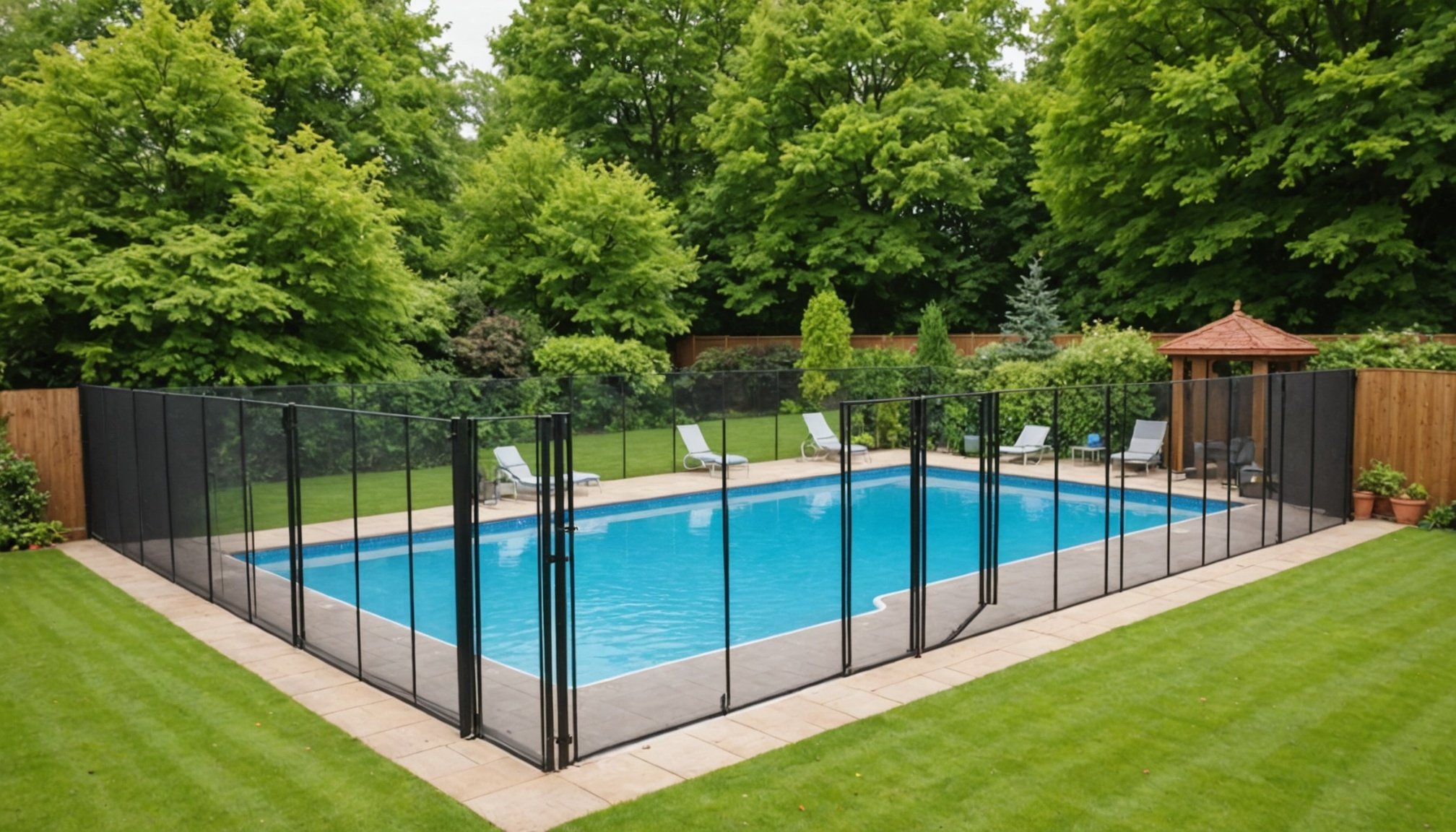Understanding the Importance of Pool Safety Fences
Navigating the landscape of pool safety regulations is crucial for pool owners in the UK. Understanding these guidelines not only ensures compliance but also safeguards loved ones. The UK mandates that pool fencing must be robust, stable, and a minimum height to effectively prevent accidents. It is imperative for homeowners to ensure their properties adhere to these regulations to avoid hefty penalties.
While safety takes precedence, the garden aesthetics should not be overlooked. Many homeowners face the dilemma of balancing practicality with visual appeal. Modern designs offer solutions that marry functionality with style, allowing for compliance without compromising on beauty. A variety of materials like glass, wood, and metal can be integrated into your landscape to enhance the overall look while serving their primary function of keeping the pool area secure.
A lire en complément : Boosting Pool Coping Longevity: Best Practices for Resilient Outdoor Spaces in the UK”s Damp Weather
Striking the right balance between functionality and aesthetic appeal involves considering UK compliance standards alongside your personal taste. Custom solutions often provide the flexibility required to match fencing with your garden’s design palette. As innovations in fence designs evolve, achieving an attractive yet compliant setup is now more feasible than ever. Ensuring a safe environment around a pool doesn’t mean sacrificing style; instead, it opens possibilities for creative solutions that align with regulatory requirements.
Effective Design Strategies for Pool Safety Fences
When designing a pool safety fence, aesthetic integration should be a top consideration. Achieving a balance between safety and aesthetics involves thoughtful design strategies that integrate seamlessly with your garden design. It’s about more than just choosing the right materials; it’s about creating a look that enhances your outdoor space.
Cela peut vous intéresser : Ultimate Guide to Balancing pH Levels for Your UK Home Swimming Pool
Incorporating natural elements into your fence design can significantly improve its visual appeal. Consider using hedges, climbing plants, or natural stone as part of the fencing structure. These elements not only provide a safety barrier but also blend beautifully with nature, making the fence a part of the landscape rather than an eyesore.
Selecting fence styles that complement existing landscaping is crucial to ensure coherence. For instance, a modern garden design could benefit from minimalistic glass panels, while a rustic yard might be better suited to wooden or wrought iron fences. The goal is to have a fence that complements, rather than competes with, your garden’s aesthetics.
Additionally, utilizing colour and texture to enhance the visual aspect of your fence can bring a fresh dynamic to your garden. Opt for colours that either contrast or complement the surrounding environment, and choose textures that add depth to the design. By doing so, your pool safety fence becomes not just a safety feature but an integral part of your outdoor decor.
Materials to Consider for Pool Safety Fences
When selecting fence materials for pool safety, consider options that blend durability with aesthetics and sustainability. Here we explore common and innovative materials, examining their pros and cons to help you make an informed decision.
1. Glass Fences:
Glass offers a sleek and modern look while maintaining high visibility. The transparent nature ensures unobstructed views, which can enhance safety by keeping the pool area visible at all times. However, glass requires regular maintenance to keep it clean and scratch-free, which might deter some homeowners looking for low-maintenance solutions.
2. Wood Fences:
Wood is traditional and provides a warm, natural appearance. It’s versatile and can be painted or stained to match any design scheme. On the downside, wood requires periodic treatment to resist weathering and can be vulnerable to pests like termites, which may affect its durability.
3. Aluminum Fences:
Aluminum is lightweight yet strong, making it an excellent choice for durability. It is resistant to rust and requires minimal maintenance, ensuring long-lasting performance. It also comes in a variety of styles and colours, allowing homeowners to achieve their desired aesthetic.
For those mindful of the environment, sustainable options like recycled aluminum or responsibly sourced wood offer eco-friendly alternatives without compromising safety and durability.
Examples of Successful Pool Fence Installations
In the UK, a number of pool fence installations have proven to be both stylish and effective. These case studies offer a wealth of design inspiration for those looking to blend safety with aesthetics. For instance, one garden in Oxford features a transparent glass barrier, harmoniously integrated with the landscape, allowing for unimpeded views while keeping the pool area secure. Another notable example in Cornwall uses natural wooden panels to complement the surrounding greenery, providing a rustic yet functional barrier.
Installation Techniques in Effective Designs
The success of a pool fence largely hinges on the installation techniques employed. In many real-world applications, professionals focus on ensuring the foundations are solid to withstand weather variations typical in the UK. A case in Manchester demonstrated the use of stainless steel posts that were anchored deeply into the ground, guaranteeing longevity and stability. Additionally, seamless integration with existing garden elements like hedges or pathways often enhances the overall design.
Lessons Learned from Successful Projects
Study of these installations highlights several lessons. Ensuring versatile designs that accommodate seasonal changes can significantly enhance both the fence’s appearance and utility. Furthermore, attention to detail during construction, such as aligning panels perfectly and using high-quality materials, are essential attributes seen in these standout projects. Lastly, a thoughtful approach to design not only improves safety but also enhances the garden’s aesthetic appeal.
Enhancing Visual Appeal with Vegetation
Incorporating vegetation into pool landscaping solutions can significantly enhance the visual appeal of your space. When considering which types of plants to integrate with pool fences, it is crucial to evaluate several factors, including the plant’s height, growth patterns, and suitability for the environment. For example, shrubs like boxwoods provide manageable height and dense growth, ideal for privacy without overwhelming the space.
Choosing the right plants not only offers aesthetic advantages but also serves practical purposes. Taller vegetation, such as bamboo, can act as a natural barrier, offering both privacy and a lush, tropical ambiance. Similarly, climbing plants like jasmine or clematis can be trained along fence lines, providing a softening effect while introducing vibrant colors.
Greenery‘s impact extends beyond visual enhancement. Strategic use of plants can create inviting and serene surroundings conducive to relaxation. Moreover, using plants that thrive in local climate conditions reduces maintenance efforts and supports sustainable landscaping practices. Leafy options, in particular, can help create shade and cool down the surrounding area.
Ultimately, the thoughtful integration of greenery can transform a pool area, offering both aesthetic value and practical benefits. Whether for privacy or simply to create a more beautiful setting, landscaping solutions play a vital role in achieving the desired visual outcome.
Compliance with UK Regulations
Navigating the UK regulations around building projects can be a complex endeavour. To ensure safety compliance, there are critical legal requirements that must be followed. Firstly, one must be aware of the key regulations concerning the height and type of materials used in construction. These laws are in place to maintain stability and prevent accidents, mandating that materials are not only durable but also sustainable and suitable for the intended purpose.
Permits play a significant role in the building process. Obtaining the necessary permissions is not just a formality; it is a legal requirement that guarantees your project adheres to local standards. Failure to secure these permits can result in severe consequences, including fines and having to undo or modify unapproved work.
To assure compliance and maintain high safety standards, seeking professional guidance is crucial. Experts can provide insights into the nuances of regulations and help navigate the intricate application procedures. Ignoring these can lead to non-compliance, which can be costly and dangerous. Emphasizing adherence to rules not only ensures legality but also protects everyone involved, from builders to future occupants, ensuring that every project contributes positively to the community.











